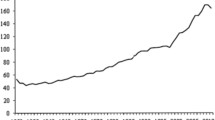Abstract
There is an emerging consensus among economists that the trend rate of economic growth in the U.S. is much lower now than in the past. In a lower-trend-growth regime, short-term equilibrium real interest rates are lower, all else being equal. In these circumstances monetary policymakers have less room to cut policy rates before hitting the zero lower bound and relying on unconventional policy tools to provide additional accommodation. Moreover, preserving the Fed’s credibility for providing sufficient accommodation to achieve our symmetric inflation objective and maximum employment remains an important consideration. Therefore, risk-management policies favor skewing policy today to lower the chances of facing more difficult zero-lower-bound outcomes in the future.
Similar content being viewed by others
Notes
Evans (2016).
The neutral, or equilibrium, real interest rate is the rate consistent with the full employment of the economy’s productive resources. This rate is sometimes also called the natural interest rate.
The 2 percent inflation target, as measured by the annual change in the Price Index for Personal Consumption Expenditures (PCE), was first acknowledged in Federal Open Market Committee (2012b).
The neutral, or equilibrium, federal funds rate is the funds rate associated with a neutral monetary policy (policy that is neither expansionary nor contractionary).
Four times a year the FOMC releases its Summary of Economic Projections, which presents FOMC participants’ forecasts of key economic variables over the next three years and for the longer run. See Federal Open Market Committee (2016).
This is 200 basis points short of the 500 or so basis point reductions implemented in other slowdowns, though, to be fair, most of these earlier rate cuts started with the fed funds rate above its long-run neutral level.
In the U.S., we dealt with the ZLB impediment in a number of ways, including the purchases of large volumes of Treasury bonds and government-sponsored enterprise (GSE) securities and the provision of forward guidance about how long the federal funds rate would stay very low. See Board of Governors of the Federal Reserve System (2015a, b).
Financial Crisis Inquiry Commission (2011, p. 354).
Draghi (2012).
Congressional Budget Office (2016).
Total factor productivity refers to the technologies and operational systems that businesses use to combine various inputs into outputs. In other words, it captures the residual growth in total output of the national economy that cannot be explained by the accumulation of measured inputs, such as labor and capital.
See Fernald (2016) for a discussion of changes in total factor productivity growth over time.
For details on the Fed’s dual mandate, see Federal Reserve Bank of Chicago (2017).
References
Bernanke, Ben. 2005. “The Global Saving Glut and the U.S. Current Account Deficit,” http://www.federalreserve.gov/boarddocs/speeches/2005/200503102/.
Board of Governors of the Federal Reserve System. 2015a. “What were the Federal Reserve’s large-scale asset purchases?” Current FAQs, December 22, https://www.federalreserve.gov/faqs/what-were-the-federal-reserves-large-scale-asset-purchases.htm.
Board of Governors of the Federal Reserve System, 2015b. “What is forward guidance and how is it used in the Federal Reserve’s monetary policy?,” Current FAQs, December 16, https://www.federalreserve.gov/faqs/what-is-forward-guidance-how-is-it-used-in-the-federal-reserve-monetary-policy.htm.
Congressional Budget Office. 2016. An Update to the Budget and Economic Outlook: 2016 to 2026, https://www.cbo.gov/publication/51908.
Draghi, Mario. 2012. Speech at the Global Investment Conference, London, July 26, https://www.ecb.europa.eu/press/key/date/2012/html/sp120726.en.html.
Evans, Charles L. 2016. “Are Lower Rates Here to Stay?” Speech, Executives’ Club of Chicago, December 5.
Federal Open Market Committee. 2012a. Press Release, December 12, https://www.federalreserve.gov/newsevents/press/monetary/20121212a.htm.
Federal Open Market Committee, 2012b. Press Release, January 25, https://www.federalreserve.gov/newsevents/press/monetary/20120125c.htm
Federal Open Market Committee, 2016. Summary of Economic Projections, December 14, https://www.federalreserve.gov/monetarypolicy/files/fomcprojtabl20161214.pdf.
Federal Reserve Bank of Chicago. 2017. “The Federal Reserve’s Dual Mandate.” https://www.chicagofed.org/research/dual-mandate/dual-mandate.
Fernald, John G. 2016. “Reassessing Longer-run U.S. growth: How Low?” Federal Reserve Bank of San Francisco Working Paper No. 2016-18, http://www.frbsf.org/economic-research/files/wp2016-18.pdf.
Financial Crisis Inquiry Commission. 2011. The Financial Crisis Inquiry Report, https://www.gpo.gov/fdsys/pkg/GPO-FCIC/pdf/GPO-FCIC.pdf.
Greenspan, Alan. 2005. Testimony before the U.S. Senate Committee on Banking, Housing and Urban Affairs, February 16, https://www.federalreserve.gov/boarddocs/hh/2005/february/testimony.htm.
Laubach, Thomas, and John C. Williams. 2003. Measuring the natural rate of interest. Review of Economics and Statistics 85(4):1063–1070.
Laubach, Thomas, and John C. Williams, 2016. Laubach and Williams Updated Estimates, Federal Reserve Bank of San Francisco, November 29, http://www.frbsf.org/economic-research/files/Laubach_Williams_updated_estimates.xlsx.
Author information
Authors and Affiliations
Additional information
*Charles L. Evans is the ninth president and chief executive officer of the Federal Reserve Bank of Chicago. Before becoming president in September of 2007, Evans served as director of research and senior vice president, supervising the Bank’s research on monetary policy, banking, financial markets and regional economic conditions. Prior to that, Evans was a vice president and senior economist with responsibility for the macroeconomics research group. His personal research has focused on measuring the effects of monetary policy on U.S. economic activity, inflation and financial market prices. It has been published in the Journal of Political Economy, American Economic Review, Journal of Monetary Economics, Quarterly Journal of Economics and the Handbook of Macroeconomics. Evans has taught at the University of Chicago, the University of Michigan and the University of South Carolina. He received a bachelor’s degree in economics from the University of Virginia and a doctorate in economics from Carnegie-Mellon University in Pittsburgh.
Rights and permissions
About this article
Cite this article
Evans, C.L. Comments at the Panel “Responders of First or Last Resort: Central Bank Strategies in an Era of Ultra-Low Interest Rates”. Bus Econ 52, 3–6 (2017). https://doi.org/10.1057/s11369-017-0028-2
Received:
Accepted:
Published:
Issue Date:
DOI: https://doi.org/10.1057/s11369-017-0028-2




